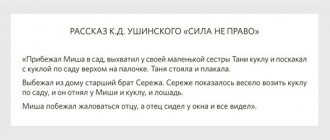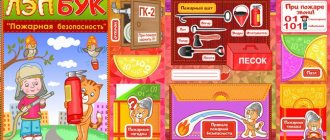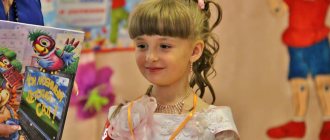You can't live in the world without music
Contained in sections:
- Autumn. Scenarios for calendar holidays 828
- Music director job 10928
Showing publications 1-10 of 110. All sections | Music Day, October 1
New
Photo
The best
Scenario of the holiday for Music Day in kindergarten “International Music Day” in the preparatory group of a preschool educational institution
Celebration script for Music Day in kindergarten . "International Music Day "
in the preparatory group of a preschool educational institution Author: Volkova Irina Vladimirovna, Gorshkova Olga Nikolaevna,
musical directors of MBDOU No. 182, Ivanovo. Goal: Introducing children to the art of music , forming...
Scenario of entertainment for Music Day for children of the senior group “Musical Ring” Goal: to form the foundations of musical culture . Objectives: – to develop in children emotional responsiveness to musical works ; – develop a sense of rhythm, auditory attention; - cultivate a love of music . Equipment: on the central wall there are treble and bass clefs, notes,…
Music Day, October 1 – Leisure scenario “International Music Day” for children 5–7 years old
Publication “Leisure scenario “International Music Day” for children 5–7...”
LEISURE SCENARIO on the theme “International Music Day” for children 5–7 years old Goal: To cultivate in children a sustainable interest in music, to expand musical impressions. Objectives: Development of artistic and aesthetic education. Encouragement for active creative activity. Formation…
Image library "MAAM-pictures"
Scenario of thematic leisure in the middle group “Music Day”
“Journey to a musical country” (thematic leisure for the middle group) Ved: We are starting an unusual concert, And not quite the usual one, Our concert is a journey To a beautiful country. A country where sounds flow, Where there is no place for boredom, Where everyone sings, plays, And the heart skips a beat! Well,…
Music Day for preschool children 5–7 years old Music Day for preschool children 5–7 years old Screen: splash screen (October 1 is World Music Day) The phonogram sounds (harp. Enter the Music Fairy Lyra Music Fairy: Hello, guys! I came today to visit you, because October 1 is World Music Day. We...
Photo report on World Music Day entitled “You can’t live in the world without music” for preschoolers of preschool educational institutions
World Music Day was held on October 1, 2022 at the MBDOU “Kindergarten No. 3 of a combined type” in the city of Pikalevo under the title “You can’t live in the world without music” for preschoolers. The festive musical event was prepared and conducted by music director Lyudmila...
Music Day, October 1 - Consultation for teachers “Fate, inspired by Music” for the International Music Day at MAAM
Article “Consultation for teachers “Fate, inspired by Music” to...”
Lyudmila Rybakova Consultation for teachers “Fate, inspired by Music.” To the International Day of Music at MAAM. (The photos presented in the article were taken by me). The year 2020-2021 in Russia, as well as throughout the World, has been declared the Year of Beethoven and the Year of Germany in Russia. In the 18th century - not to be...
Photo report on the musical trip on International Music Day
Music is the language of the heart, because it makes you feel. Music can tell things that words cannot say. The more a child learns about music, the more he will understand its beautiful language, the wider his horizons will be. The main task of music is to awaken emotions in people...
Scenario for the “Day of Music” holiday for children of senior preschool age
Goal: Expand children's understanding of music. Objectives: • To introduce the sound of musical instruments. • Arouse interest in music. • Expand your knowledge of famous classical music performers. • Involve children in participating in activities. Event…
Scenario for the Day of Music “Oh, a magical land of music” SCRIPT FOR THE DAY OF MUSIC “Oh, music, a magical land!” (Children enter the hall to the song “Ode to Music” (“Music from the sky will fly in verses...” On the screen there is a beautiful 3D screensaver with a view of the musical kingdom. The presenters come out to a magical, fairy-tale melody) Presenter 1 ...Music embraces us...
Pages: …
Zatsepina M.B. Music in kindergarten
In addition to the various dates that are customary to celebrate in our country, there are a number of wonderful international days that are celebrated in many countries around the world. There are many such holidays, for example:
International Earth Day - April 22, International Bird Day - April 1, International Theater Day - March 27, International Museum Day - May 18, etc.
Some holidays have already entered the life of the kindergarten, others have not yet. You can gradually introduce children to them by organizing themed days or impromptu holidays. They will have great educational value, since preschoolers will not only gain additional knowledge about the world around them, but will also become familiar with universal human values.
One of the holidays that will interest children is International Music Day. It began to be celebrated on October 1, 1975 by decision of UNESCO. One of the initiators of its establishment was composer Dmitry Shostakovich. Music Day is celebrated annually all over the world with large concert programs with the participation of the best artists and artistic groups. On this day, musical works included in the treasury of world culture are played.
Events organized in kindergarten for Music Day allow children to be “immersed” in the world of beauty and contribute to the formation of an aesthetic attitude towards music, which N.A. Vetlugina defined as a reflection of music in the mind of a preschooler and the establishment of interactions between them. Aesthetic attitude expresses the personal experience of a preschooler and determines his actions and experiences related to music. Therefore, the importance of an aesthetic attitude to music in the development of personality is great. If a child is passionate about art, admires the beautiful, kind, expressed in music, then this solves the main task of moral and aesthetic education and successfully develops a variety of musical skills.
Organizing a holiday requires teachers to have a creative approach, erudition and love of music. The main thing is to remember that children are active participants. The material on which the work is based should be accessible, familiar, and interesting to children. There is no need to overload preschoolers; it is important to bring joy, pleasure into the atmosphere and create a good mood in children. We invite you to familiarize yourself with the work experience of G. E. Zhukova, music director of the State Educational Institution “Kindergarten No. 2278” of the South-Eastern District Education Department of Moscow.
"Music Day" in the junior group
The teacher tells the children: “Today the doll Tanya came to visit us. This doll is very cheerful - she loves to sing and dance, listen to music. Doll Tanya brought handkerchiefs with her and invites you and me to play with them.”
The game “Funny Handkerchiefs” is being played (developing a reaction to a change in dynamics), authors I. G. Galichenko, M. A. Mikhailova. Children with handkerchiefs in their hands dance to cheerful loud dance music, inventing their own movements. With a change in dynamics (the dance song sounds quiet), the children sit down and hide behind their handkerchiefs.
Then the teacher says that the Tanya doll really likes to play with rattles - they ring very happily, and invites the children to complete the application “Multi-colored rattles.” Children glue ready-made shapes.
The teacher tells the children that they need to rest a little and invites them to go for a “walk” with the doll Tanya.
The game “Walk”, author N. G. Kononova, is being played. Musical hammers are given to children. The teacher says: “Our walk will be unusual, you will walk, and musical hammers will help you. Here we are going down the stairs,” the teacher slowly hits his palm with a hammer. Children repeat the same rhythmic pattern. “And now we went outside - the sun was shining, everyone was happy and ran. This is how running is conveyed with frequent blows. Tanya took the ball and began to slowly hit it on the ground,” the teacher again slowly hits the hammer. Children repeat. “The rest of the children started jumping quickly. Skok, skok,” they quickly hit with hammers. Children repeat. “But suddenly a cloud appeared in the sky, covered the sun, and it began to rain. At first it was small, rare drops, then a heavy downpour began,” the teacher gradually speeds up the rhythm of hammer strikes. Children hit the hammers quickly and rhythmically. “Our unusual walk is over, let’s put the hammers back in place,” says the teacher.
During a lesson on familiarization with fiction, you can read G. Vieru’s poem “The Hedgehog and the Drum” and offer to voice it.
A hedgehog walks with a drum, the hedgehog plays all day long. With a drum behind his shoulders, the Hedgehog accidentally wandered into the garden. He loved apples very much, He forgot the drum in the garden. At night, apples were torn off, and blows were heard. The hares got very scared, they didn’t close their eyes until dawn!
You can compare the sizes of the drums: large and small drums, the number of bells - one and many, etc.
In the afternoon, the teacher tells the children that her friends came to visit the children along with the doll Tanya.
The game “Guests have come to us”, author N. G. Kononova, is being played. The teacher quietly puts a bibabo bear toy on his hand: “Hello, children, I came to visit you to play and dance with you. Play the tambourine for me, I’ll dance.” The selected child slowly hits the tambourine, the bear in the hands of the teacher rhythmically moves from foot to foot. Children clap. In a similar way, the teacher plays up the arrival of other toys: a bunny jumps to the rapid blows of a hammer on a metallophone, a horse gallops to the clear rhythmic beats of a musical hammer, a bird flies to the ringing of a bell.
You can also play another didactic game - “Teaching a doll to dance”, author of the game M. A. Davydova (musical accompaniment - Russian folk song “In the garden, in the vegetable garden”). During the game, children perform actions with a real or imaginary doll. The teacher or music director offers the children to teach the doll to dance. The doll, together with the children, makes steps and dance movements while an adult sings.
Then the Tanya doll and the animals ask the children to show them a concert. The teacher asks the children who wants to sing a song or dance. Those who wish can perform numbers.
"Day of Music" in the middle group
The teacher tells the children: “Today will be an unusual day - music will accompany you everywhere. A lot of interesting things await you. But first you need to guess the riddle, only the riddle is not easy - it’s musical.”
Children listen to the play "Sparrow", music. A. Rubbach or “Sparrows” by M. Krasev. The teacher asks the children what the name of this music is. If the children find it difficult to answer, the teacher asks them leading questions or reads a poem:
- Chik-chirp! - Mom said. - Chik-chirp! - said the father. But the son was stubborn: “Chiki-rik!” - said the chick. - Chiki-rik! - Mom said. - Chiki-rik! - said the father. But the son was stubborn: “Chick-chirp!” - said the chick. (V. Levanovsky)
After the children guess the name of the play, the teacher says that today is an unusual day, even a little magical, and therefore she can turn them into sparrow birds. The game “Birds and the Crow” is being played (A.I. Burenina. Rhythmic mosaic. Rhythmoplasty program for children. - St. Petersburg, 2000). The role of the leader in the game is played by the teacher.
During a visual arts lesson, the teacher invites the sparrow children to create their own portraits. He hands out ready-made forms of different sizes - large birds and chicks - and offers to fill them using the butting method.
Before starting work, you need to prepare your hands - do finger exercises.
In the nest.
A bird sleeps in the nest at night (the fist of the right hand lies on the palm of the left). The fox is sleeping in a hole (the arms turn over, the left hand clenches, hiding the right fist). The bug is sleeping under a leaf (the left palm is straightened over the right fist), the Dog is in the kennel (the arms are folded “house” above the head, the neck is extended). (E. Zheleznova)
After warming up, the teacher invites the children to seat (glue) the birds on a tree (it is drawn in advance on a large sheet of Whatman paper). Large birds should be placed low on large (wide, long) branches, and small birds should be placed high on small (narrow, short) branches (consolidating mathematical skills).
Then the teacher invites the children to sing E. Tilicheeva’s song “Chicks,” playing along on the metallophone. Next, the game “Birds and Chicks” is played, according to the principle of the game proposed by N. G. Kononova. The teacher plays low and high sounds on the metallophone (up to 1 and up to 2) and invites the children to show on the application they made who sings this song: the mother bird or the chick, and sing the song in a high or low voice instead of the bird.
During a music lesson, you can start learning or repeat a previously learned song about sparrows or any song about birds, for example, “Sparrow”, music and lyrics by I. Konvenan; play the game “Sparrows and the Car”, author L. Mikhailova (“Music in kindergarten”, compiled by Vetlugina N.A., “Music”, 1989).
In the afternoon you can play the game “Our Orchestra”, author N. G. Kononova. The teacher tells the children that they have received a package. He shows it, takes out musical instruments and gives them to the children (you must first introduce the children to musical instruments in class). Everyone plays instruments the way they want. After the “creative” game, the teacher offers to listen to the orchestra of the older children or one of the parents play.
Read the full text of the article in the SDO magazine








